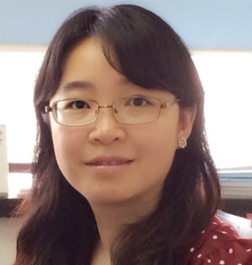
MD; Ph.D., Fudan University
Professor
Email: ruihe@fudan.edu.cn
Phone Number: 86-21-54237419
Lab Staff and Students
4 PhD students; 2 Master students; 2 postdoctors
Research Interests
Dr. Rui He’s research area is focused on immune regulation of cellular immunity and the biological function of inflammatory mediators in mucosal inflammation. The mucosal immune system is primarily located in airway and digestive tissues, and continuously exposed to a variety of antigens. A striking rise in the prevalence of several inflammatory diseases including asthma and inflammatory bowel diseases has been observed worldwide over last two decades. Furthermore, it is widely accepted that chronic inflammation in airway and digestive tissues predisposes individuals to lung cancer, liver cancer, gastric cancer and colon cancer. Thus, the identification of critical effector cells and molecules and their regulatory effects in the initiation and the development of inflammatory responses occurring in the mucosal surface is important to broaden our understanding of the pathogenesis of inflammatory diseases and inflammation-related cancer and to develop novel therapeutic strategies.
Our current study has been focused on the role of leukotriene B4 (LTB4) and chemerin, two inflammatory mediators that are up-regulated in several inflammatory diseases and inflammation-related cancer. The LTB4-BLT1 axis actively participates in inflammation by recruiting and activating various immune cells. We previously demonstrated that the LTB4-BLT1 interaction regulates a neutrophil-T cell axis, which is required for allergic skin inflammation (Immunity, 2012), and we also revealed a novel anti-inflammatory role of the LTB4-BLT1 axis in acute lung injury by mediating alveolar recruitment of regulatory T cells (AJRCCM, 2012). Chemerin is originally identified as a chemoattractant protein. Recent studies have suggested that chemerin seems to play opposing roles, either pro- or anti-inflammatory, depending on the context of tissue inflammation. Our studies highlight the complex function of chemerin in regulating tissue inflammation and suggest chemerin as a potential therapeutic target for allergic asthma and inflammatory bowel disease. ( Zhao et al, Allergy, 2014; Lin et al, Cellular & Molecular Immunol,2014; Yin et al, Autoimmunity, 2014).
PUBLICATIONS (* Corresponding author)
1. Zhao L, Yang W, Yang X, Lin Y, Lv J, Dou X, Luo Q, Dong J, Chen Z, Chu Y and He R*. Chemerin suppresses murine allergic asthma by inhibiting CCL2 production and subsequent airway recruitment of inflammatory dendritic cells. Allergy 2014 Jun;69(6):763-74.
2. Lin Y, Yang X, Yue W, Xu X, Li B, Zou L and He R*. Chemerin aggravates DSS-induced colitis by suppressing M2 macrophage polarization. Cellular & Molecular Immunol 2014 Jul;11(4):355-66
3. Yin Q, Xu X, Lin Y, Lv J, Zhao L, and He R*. Ultraviolet B irradiation induces skin accumulation of plasmacytoid dendritic cells: A possible role for chemerin. Autoimmunity 2014 May;47(3):185-92.
4. Wang L, Zhao L, Lv J, Yin Q, Liang X, Chu Y and He R*. BLT1-dependent alveolar recruitment of CD4+CD25+ Foxp3+ regulatory T cells is important for resolution of acute lung injury. Am J Respir Crit Care Med 2012, 186(10):989-98.
5. Oyoshi MK, He R (Co-first author), Li Y, Mondal, S, Yoon J, Afshar R, Chen M ,Lee DM, Luo HR, Luster AD, Cho JS, Miller LS, Larson A, Murphy GF and Geha RS. LTB4 driven neutrophil recruitment to the skin is essential for allergic skin inflammation Immunity 2012, 37(4):747-58
6. He R, Oyoshi MK, Wang JY, Hodge MR, Jin H, and Geha RS. The prostaglandin D(2) receptor CRTH2 is important for allergic skin inflammation after epicutaneous antigen challenge. J Allergy Clin Immunol. 2010; 126(4):784-90
7. Oyoshi MK, He R, Elkhal A, Kawamoto S, Lewis C, Kanaoka Y, Austen KF, and Geha RS. Eosinophil-derived LTC4 signals via CysLT2R to promote skin thickening and collagen deposition in a mouse model of allergic skin inflammation. Proc Natl Acad Sci USA 2012;109(13):4992-7
8. He R, Kim HY, Yoon J, Oyoshi MK, MacGinnitie A, Goya S , Bryce P, Freyschmidt EJ, McKenzie AJ, Umetsu DT, Oettgen HC and Geha RS. Exaggerated IL-17 response to epicutaneous sensitization mediates airway inflammation in the absence of IL-4 and IL-13. J Allergy Clin Immunol 2009; 124(4):761-770.e1
9. He R and Geha RS. Thymic Stromal Lymphopoietin. Ann N Y Acad Sci. 2010;1183:13-24
10. Oyoshi MK, Elkhal A, Kumar L, Scott J, Koduru S, He R, Leung DY, Howell MD, Oettgen HC, Murphy GF, and Geha RS. IL-17 promotes dissemination of vaccinia virus in a mouse model of eczema vaccinatum. Proc Natl Acad Sci USA 2009;106(35):14954-9
11. Oyoshi MK, He R, Kumar L, Yoon J and Geha RS. Cellular and molecular mechanisms in Atopic dermatitis. Adv Immunol 2009;102:135-226
12. He R, Oyoshi MK, Garibyan L, Kumar L, Ziegler SF and Geha RS. TSLP acts on infiltrating effector T cells to drive allergic skin inflammation. Proc Natl Acad Sci USA 2008; 105(33):11875-80
13. He R, Oyoshi MK, Jin H, Geha RS. Epicutaneous antigen exposure induces a TH17 response that drives airway inflammation after inhalation challenge. Proc Natl Acad Sci USA 2007; 104(40): 15817-22
14. Jin H, He R (Co-first author), Oyoshi MK, Geha RS. Animal models of atopic dermatitis. J Invest Dermatol; 2009; 129(1):31-40
15. Yalcindag A, He R*( Co-first author), Laouini D, Alenius H, Carroll M, Oettgen HC, Geha RS. The complement component C3 plays a critical role in both Th1 and Th2 responses to antigen. J Allergy Clin Immunol. 2006; 117(6):1455-61.
16. Elkhal A, Pichavant M, He R, Scott J, Meyer E, Goya S, Geha RS, Umetsu DT. CD1d restricted natural killer T cells are not required for allergic skin inflammation. J Allergy Clin Immunol. 2006;118(6):1363-8
17. Xu ZS, Liu YJ, Lv LL, Han ZB, He R, Lu SH, Wang T, Xu B, Chen ZZ, Han ZC. Bone marrow stromal cells transduced with human hemangiopoietin gene support hematopoiesis in vitro. Haematologica. 2005;90(2):157-65
18. He R, Liu B, Yang C, Yang RC, Tobelem G, Han ZC. Inhibition of K562 leukemia angiogenesis and growth by expression of antisense vascular endothelial growth factor (VEGF) sequence. Cancer Gene Ther. 2003;10(12):879-86
